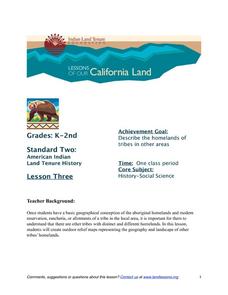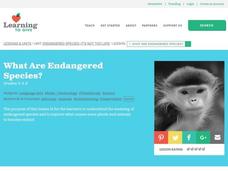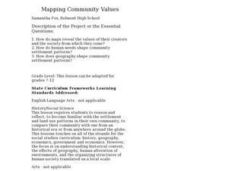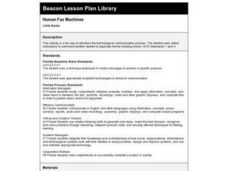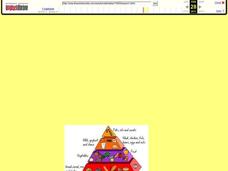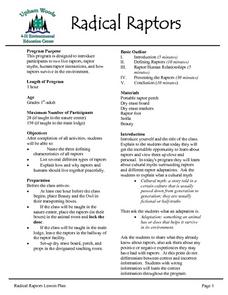Curated OER
What Are Cells?
Energize the cells of young biologists with an edible life science activity. Engaging learners in exploring the inner workings of plant and animal cells, this activity involves using colored jello and various sweet and tasty treats to...
CK-12 Foundation
Limiting Factors to Population Growth: Graphing Population Growth
If any of the limiting factors in an environment change, both animal and plant populations also change. The video explains two different models of growth and the impact of limiting factors. It highlights the carrying capacity of an...
Indian Land Tenure Foundation
More Tribal Homelands
Here is a very fun idea that introduces young learners to how geographical location affects cultural development. They are introduced to four areas where Native Americans have lived in the past by reading stories and examining images....
Curated OER
Nuclear Chemistry Project
Radiation has numerous real-world applications, some of which are relatively safe while others can be extremely hazardous. In this nuclear chemistry project, young scientists choose a practical use of nuclear reactions to research in...
Serendip
How Do Biological Organisms Use Energy?
When an organism eats, how does food become energy? Young biologists follow glucose through the process of cellular respiration to the creation of ADP using a discussion-based activity. The resource also highlights conservation of mass...
K12 Reader
African American Inventors: Patricia Bath
Young readers practice their comprehension skills by responding to a series of text-based questions on a passage about Patricia Bath, the first black woman medical doctor to receive a patent.
Curated OER
Who Made Breakfast
Students examine animal rights by researching factory farm methods. In this animal abuse lesson, students identify how many ingredients used in their breakfast come from animals. Students research the health hazards caused to humans by...
Curated OER
Haiti: Still in Crisis, but No Longer in the News
Pupils study the Haitian crisis and learn about the needs and ways to help the situation. In this Haitian crisis lesson, students study the Maslow's "Needs Pyramid". Pupils study the media coverage of the earthquake and then answer...
Curated OER
Exploring Ecosystems
Fourth graders create an ecosystem as a class. They have already produced smaller ones. They use a pond or something similar on school grounds to meet the needs of certain plants and animals of their ecosystem. Specifically created will...
Curated OER
What Are Endangered Species?
Students explore the concepts of endangered and extinct animals. In this animal protection lesson, students discuss and define the words endangered, extinct, and habitat. Students share why they think it is important to protect...
Curated OER
Understanding Life System: Growth and Changes in Plants
Third graders research ways in which plants are essential to humans. In this Global Peace instructional activity, 3rd graders participate in tasks, such as creating a propaganda poster. Students may watch the film, The Lorax, as a...
Curated OER
Mapping Community Values
Students discuss the origin of various maps focusing on the values behind them. Students also explore how human needs and geography influence community settlement patterns. Students extend learning by creating and mapping their own ideal...
Curated OER
Major Functions
Seventh graders investigate the basic characteristics and needs of living things. They identify the major parts of plants and animals by making lists. Students focus upon one living thing and speculate how if one part is changed how it...
Curated OER
Can You Make It? Using Natural Resources to Survive
Seventh graders describe the natural resources used to make the tools and weapons which best suited the needs of the Cherokee Indians. They will collect information regarding the making of a tool or weapon, and then explain to others...
Curated OER
Experiencing Tiananmen Square
Students investigate the Tiananmen Square demonstration and massacre in China. They watch a video clip, in small groups conduct Internet research, present their findings to the class, simulate a demonstration, and create an art project.
Curated OER
Darfur Now Lesson One: Introduction to Darfur Now
Students view a brief film and define vocabulary terms related to genocide. In this civics instructional activity, students discuss motivations of people to take action against the crisis in Darfur. Students write responses to the film...
Curated OER
What Can We Learn from Artifacts?
Students examine how artifacts are discovered and explore their significance as it pertains to gathering important information. In this artifacts lesson, students obtain knowledge about the way artifacts are excavated and examine an...
Curated OER
Mandela The Man
Ninth graders explore civil rights by reading several biographies. In this Nelson Mandela lesson, 9th graders discuss the trials and tribulations Nelson Mandela had to face in South Africa and how they were similar to the problems Martin...
Curated OER
Defining Culture
Students explore cultural diversity. In this cultural awareness lesson, students examine the similarities and differences in various cultures and discuss the value of these differences.
Curated OER
Human Fax Machines
Fourth graders discover how to communicate effectively by giving oral directions to make a peanut butter and jelly sandwich. They work with a partner and give oral directions for block building.
Curated OER
Microbes 1: What's Bugging You?
Learners build on existing knowledge of microbes, focusing on the relationship between microorganisms and foodborne illness, as well as the implications that foodborne illness has on human health.
Curated OER
Food Pyramid
Students identify good nutrition. In this food pyramid lesson, students learn the basics of good nutrition, identify the six basic food groups, state the effects of the food on the human body, and learn nutritional information while...
Curated OER
Hunger/ Nutrition
Seventh graders investigate nutrients and nutrition to determine what types of food the body needs for energy. They study each type of nutrient and why it is important to the body. They determine what a balanced diet is by completing the...
Curated OER
Radical Raptors
Students are introduced to raptors and their role in the environment. They identify three characteristics of raptors and list several types of raptors found in nature. They discuss their positive and negative experiences with raptors and...




